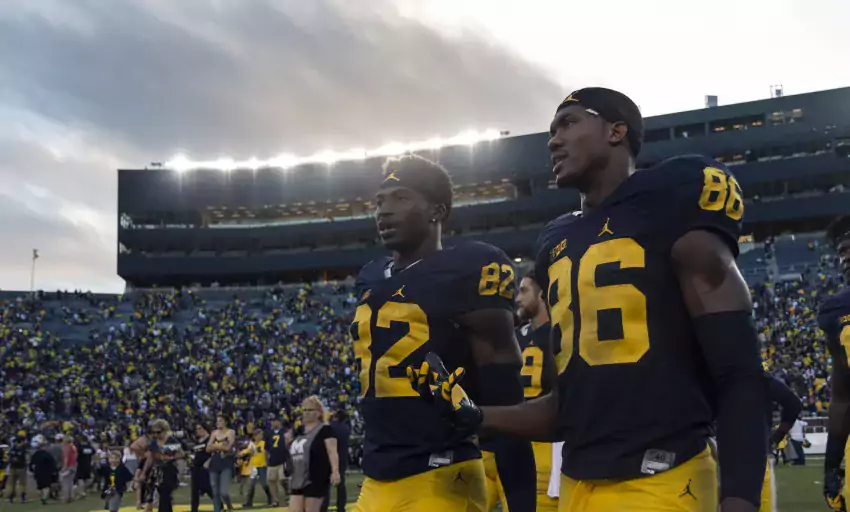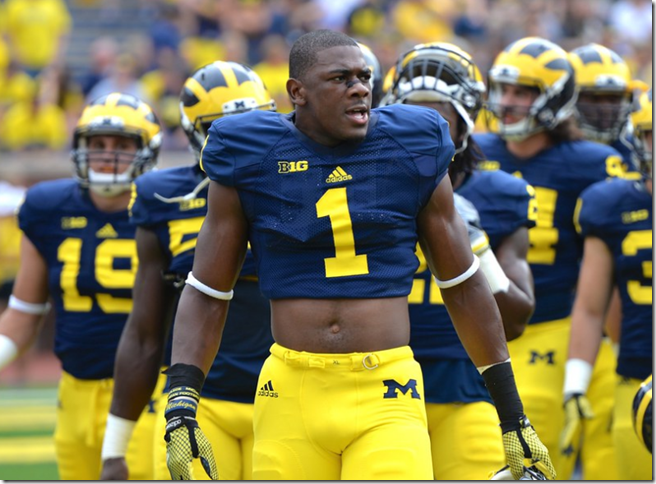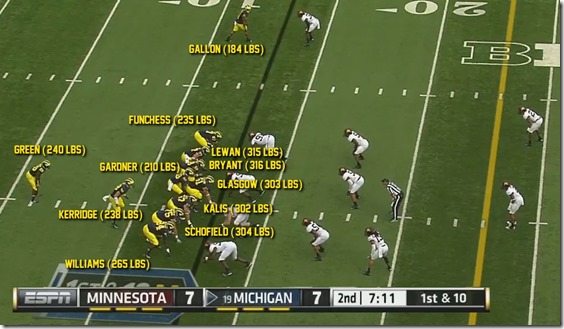devin funchess wide receiver possibility

Previously: 2008 Offense, 2008 Defense, 2009 Defense, 2009 Quarterbacks, 2009 Offense, 2010 Offense, 2010 Defense, 2011 Offense, 2011 Defense
This used to be a thing on MGoBlog, until the 2011 class depressed Ace so badly that he gave up afterwards. Someone would have to be extremely desperate for content to dig this up and get caught up. Or just incredibly brave. And stupid. Probably all.
This was Brady Hoke's first real class, since he only had a few weeks in 2011 to tack on a few fliers to whatever had stuck around. The unicorn poop run of 2011 fueled belief that the goofy guy might actually be more clever than he let on, while the Tressel scandal in Columbus removed an important piece from the board. This was Hoke's opportunity to strike, and strike he did, building the core of what would become a senior-laden, ill-fated run at the championship in 2016. While Hoke was always better on defense, this was actually a pretty well-scouted as well as well-starred class, give or take a couple of tight ends who should have been something else.
Quick Glossary
YMRMFSPA: "You might remember me from such players as." The shorthand we use in recruiting profiles to say what type of player a guy would be if he works out.
404 Quarterback Not Found
Aaand he forgot the most important position. With Shane Morris committed for 2013 and Russell Bellomy, a late flip from Purdue, the only quarterback taken in 2011, this looked like quite the oversight at the time. I'm sure it wouldn't come back to haunt them.
The Greatest Receiving Recruiting Class Since…?
Move over, Terrell and Walker, because once you include the receiver they expected to be a tight end and the receiver they expected to be a running back, this class gave Michigan 5,573 yards and 41 touchdowns through the air (compare to the 1998 class's 4,586 yards and 40 TDs). The two African refugees, Amara Darboh (YMRMFSPA "Aw, hell, Jason Avant") and Jehu Chesson (Adrian Arrington), were cause to invoke the Legends of '98. Chesson's responses to reporters were wise beyond Craig Ross's years, Darboh got knocked for his speed in a coach quote now engraved on the FAKE 40 Times Trophy:
"He runs 4.42 but I wouldn't say that he's a burner by any stretch of the imagination," said Wilson. "He's a reliable guy that can make the tough catches for you. … he's a bigger physical presence. He's not a make you miss kinda guy."
Darboh's whole profile was like that: burly guy who's good with the ball in open space. This turned out to be a version of Avant who's really effective on smoke screens. Both stuck around into the Harbaugh era—Chesson because he arrived rail thin and redshirted, Darboh because an injury required a medshirt in 2013. Both peaked in 2015 and eschewed possible NFL opportunities for good but relatively disappointing (ungh, those drops in Iowa) senior runs. Darboh went in the 3rd round and remains with the Seahawks. Chesson, who's still pretty skinny, was drafted in the 4th round by the Chiefs and is lately hanging around on the margins of the league.
[Bryan Fuller]
Devin Funchess ("A less existentially depressed Jake Stoneburner, or Kevin Koger") was part of a four-man group of Farmington Hills Harrison (RIP) players to go Big Ten, and not even the highest-ranked receiver from his high school class. That was Aaron Burbridge, whom Michigan gave up on getting eligible for college and Michigan State somehow managed to get into school after a year of remedial stuff. Funchess was supposed to bulk up to tight end, whereupon he'd become what we want Eubanks to be this year. This wasn't as far-fetched as it appears in retrospect. The Michigan coaches thought Devin could bulk up to 240, he came in officially at 229, and his three-star profile certainly didn't give off an air of a three-and-done 1st round WR. Given zero depth at tight end, a redshirt seemed unlikely. Like his refugee classmates, the general excitement level was "High," with the suggestion he could challenge Mandich's all-time TE receiving yardage record. Because SIDs don't generally alter positions mid-season, this came to pass.
By October 2013, we had the "devin funchess wide receiver possibility" tag in existence, and soon after it was just the reality. In 2014 he switched from his tight end legends number to #1, spent most of that seasons either hurt or hurt enough not to play, and was drafted in the 2nd round. At his best he was hurdling Buckeyes and uncoverable by most cornerbacks for reasons just as apparent when we talk about Nico Collins today. After four years and 2,233 yards with Carolina he signed a one-year contract this year with the Colts.
The last receiver was the last guy added to the class. I was texting or gchatting or something with Brian as signing day was winding down and we were both complaining that jitterbug Dennis Norfleet wasn't offered. Then Michigan struck out on all of the top-end guys they were in on, added a DT, and finally Norfleet. Thus began a long battle between MGoBlog and Hoke's staff about using Norfleet as anything but the most obvious jet sweep target or dancing returner, whereat he got no TDs but set a record that will never be touched in TDs bogusly called back. By Hoke's end Norfleet was trying at cornerback and getting into academic issues that ultimately ended his career a year early.
[After THE JUMP: Who's going to block for a generation?]
That is 2,728 pounds—1.24 metric tons—in the box for those weighing at home.
On 1st and 10. MANBRAAAHHHLLL!!!
Before the Minnesota game I tweeted that I'd be perfectly content if Borges debuted a completely new package and used it to beat up on the Gophers at home a la 2011. So here I am, being content.
The unbalanced stuff I'm sure Brian will picture page and Space Coyote and Burgeoning Wolverine Star will peel it apart as well; since they know more about that stuff I'll leave it to them. What I would like to do is look at the heavy formations in the macro: how Big did Michigan actually go, how effective it was on a yards-per-play basis, and whether it matches the personnel.
By "big" I mean fewer receivers in the formation. The lower that number, the more backs and TEs, and thus the "heavier" the formation. How big?
Average Receivers in Formation:
| Season | Overall | Normal downs* |
|---|---|---|
| 2008 | 3.14 | 3.14 |
| 2009 | 2.84 | 2.90 |
| 2010 | 3.13 | 3.15 |
| 2011 | 2.59 | 2.60 |
| 2012 | 2.52 | 2.55 |
| 2013 games 1-4 | 2.30 | 2.29 |
| 2013 Minnesota | 1.83 (!) | 1.79 (!) |
That is big—like we should all have pronounced brow ridges and live in caves and the equipment sponsor is Mousterian big. I counted Funchess as a WR when he was in a 2-point stance; if you file him as a half tight end (you shouldn't) it gets even heavier. A lot of the three-wide was on the time-sensitive last drive of the 1st half—that you should count.
Did it work? Did it work better than the stuff Michigan has been doing until now? Did they always run to the side they unbalanced? We see after the jump.


25